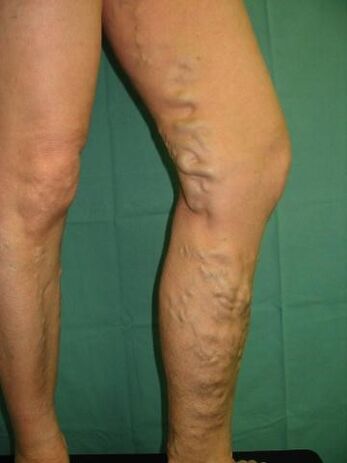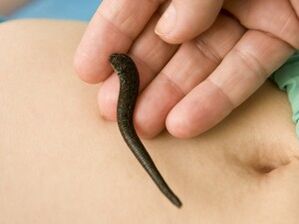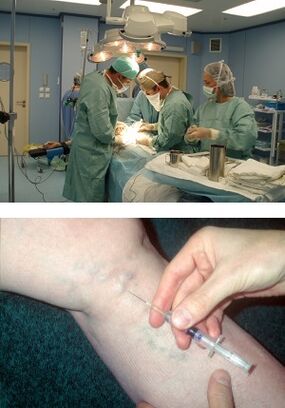Varicose veins or varicose veins in ordinary people are irreversible and permanent enlargement and dilation of veins, mainly of the lower extremities, as well as the formation of certain "nodes" as a result of pathology of the venous walls or due to a genetic defect. (Failure of their valves).
Today, varicose veins are a very common disease. It affects every tenth man and every third woman. The more people lead a sedentary, inactive lifestyle, the more susceptible they are to this disease.
USA, France, UK - are the leading countries with the spread of varicose veins (on average more than 30% of the population).
Causes of varicose veins
This benefit is manifested by an increase in venous pressure. It is generally accepted that varicose veins are located exclusively in the lower extremities, however, there are varicose veins of the esophagus, stomach, testicles or small pelvis.
By the way, the latter is one of the causes of a fairly common disease such as hemorrhoids.
The main reasons for the development of varicose veins are:
- Gender: Often varicose veins in females are provoked by taking various hormonal drugs or pregnancy.
- Inheritance
- Increased venous pressure, including due to weight problems, sedentary lifestyle.
The above causes contribute to varicose veins and disruption of the normal functioning of the venous valves.
Stages of the disease
The following stages of varicose veins are distinguished:
- Primary- Characterized by pain in the legs, swelling and heaviness. At this point disease prevention is, after all, better.
- The first stage- Nodular veins, spider veins that are seen through the skin, also add to the above symptoms. It is often possible to feel a burning sensation in the leg and calf.
- The second stage- The number of varicose veins and stars increases dramatically, becoming more visible. The pain becomes unbearable, the legs fall apart.
- The third stage- Here the skin of the feet is directly affected. It becomes cracked, lifeless and dry. In addition, it is possible to change the skin pigmentation and structure of the feet. The venous nodes begin to form convex shape.
What happens to varicose veins?

One of the first symptoms of varicose veins is frequent swelling of the legs, scattering, and heaviness when sitting in calves for a long time.
Also, varicose veins are less characterized by a reduction or disappearance of these symptoms after a night of rest or walking.
If you do not start treatment on time, the following symptoms appear - pain in the bumps, cramps in the calf muscles, feeling of heat in the legs.
Also on the legs you can see red-blue vascular "stars", the varicose veins dilate and you can see intradermal dark blue veins.
With enlarged varicose veins, thrombophlebitis (inflammation of the varicose veins with the formation of blood clots in them), eczema in the affected areas or trophic ulcers may develop.
To eliminate the risks of varicose veins manifestation it is necessary to get rid of the main causes and external factors of its origin: smoking, alcohol, unhealthy diet.
Varicose veins of the lower extremities develop due to lack of fiber-rich foods. It is an intestinal cleanser that removes wastes, pus, toxins and radionuclides from the body.
Forms of varicose veins
There are the following types (forms) of varicose veins of the lower part:
- Localized venous lesion with defective discharge through communication or abnormal veins.
- Localized damage to intradermal or subcutaneous vessels without reflux.
- Widespread venous involvement with impaired blood flow to deep veins.
- Widespread damage to the veins through defective blood flow in the communication veins.
In addition, a separate isolated form, such as the reticular form of varicose veins. It is a kind of common varicose veins, with which thin intracranial veins dilate.
Diagnosis

If you notice primary symptoms, you should immediately consult a specialist in venous diseases - phlebologist.
The success of treating varicose veins in the legs largely depends on when you start treatment. Naturally, the earlier you go to the doctor, the lower the risk of complications.
After the first examination, the doctor will order an instrumental examination, usually a Doppler ultrasound.
It happens that radioactive and radionuclide methods are used, if necessary.
These methods inject special substances into the bloodstream and then distribute them through the bloodstream.
How to treat varicose veins
Varicose veins can be treated in 3 ways:
- Sclerotherapy.
- Perform surgery on varicose veins.
- Medications (conservative treatment).
In addition to the above methods, the complex uses medical knitting clothing and physiotherapy exercises.
Below we discuss each of the 3 methods in more detail.
Sclerotherapy

Scleropy is a painless, non-surgical, and most importantly, high-quality and effective method of treating varicose veins. This is a fairly young way to treat varicose veins compared to others.
One of the main advantages of sclerotherapy is that the treatment does not require hospitalization, ie it is carried out on an outpatient basis and that it in no way affects the normal rhythm of the patient's life.
The essence of the method is that a special sclerotic drug is carefully inserted into the "diseased" vein, which causes a kind of "stickiness" of the veins.
After the procedure is applied with a bandage, which should be worn for a week. During this time, the vein swells, after which it disappears and blood circulation is restored.
Unfortunately, not all types of varicose veins can be treated with this method. If the patient needs surgery, then sclerotherapy in this case not only does not help, but can lead to a number of complications and possibly even worsening.
For example, there is a classification of varicose veins according to the search, where varicose veins are divided into degrees and this method can treat only grade 1 varicose veins.
As for the results of sclerotherapy, it is the maintenance of small bruises for a short period of time and slight pigmentation of the "diseased" veins.
This method performed by a professional doctor guarantees a long-lasting result: varicose veins "close" and blood flow never returns to them.
ᲝOperation
Surgical treatment of varicose veins or laser surgery of varicose veins. Currently, this method is one of the main ones. For one, there are many contraindications:
- During pregnancy or in newborn women, it is recommended to wait at least 5 weeks, because in many cases, the varicose veins that develop during pregnancy go away on their own without any intervention.
- If you are concerned exclusively with the aesthetic side of the problem and there are no other symptoms (inflammation of the veins, pain).
- The surgical method of treating varicose veins is shown only if it makes no sense to others or does not bring results.
Treatment of varicose veins is performed surgically, usually on an outpatient basis, without hospitalization of the patient.
There are 3 methods of surgical treatment of varicose veins - ligation, striptease and microphlebectomy.
- Ligation- This is a kind of ligation of varicose veins. Typically, this method is used in conjunction with others, for example, it serves to augment striptease or phlebectomy.
- Striptease- A surgical method of treating varicose veins in which a "diseased" vein is removed using a thin small probe.
- Microflebectomy- The essence is that the varicose veins are removed through a puncture made in the skin.
Method of medical treatment
Drug therapy is an equally important component in the treatment of varicose veins. Competently selected medications will not only help to remove the rather basic manifestations of varicose veins, but also reduce the risk of complications.
Most of these medications help relieve swelling and pain syndromes, improve blood flow, and so on.
These medications help the following:
- Improving lymphatic drainage function.
- Increase venous general tone.
- Improve the microcirculation of hematological disorders.
It should be noted that the use of these drugs, like any other, should be carried out exclusively after a thorough examination and in the manner prescribed by your doctor.
Treatment of varicose veins with folk remedies
In addition to traditional medicine, there are also recipes from the "folk" first aid kit:
- Take a few cloves of garlic and finely chop. Note that only garlic with a white skin is used! Then mix two tablespoons of butter. We apply the resulting gruel "sore" veins overnight, on top of parchment paper, secured with a tight bandage and finally wrapped it in a warm scarf. In the morning, after the shower, we wear something warm.
- Hop infusion is an equally effective folk remedy against varicose veins. Take the hop cones (be sure to dry) and pour 1 cup boiling water. Let stand for an hour and then freely take the infusion in a glass half an hour before eating.
And remember varicose veins are not a suggestion, it is still possible and necessary to treat and the sooner you consult a specialist, the easier and more effective the treatment itself will be.
ოს Be healthy!




































